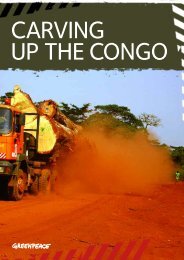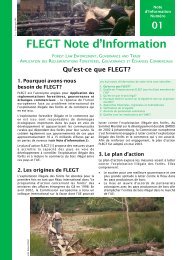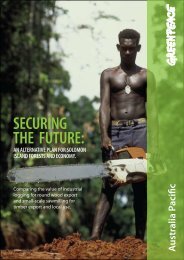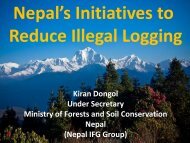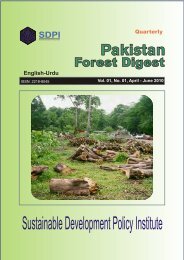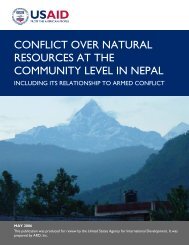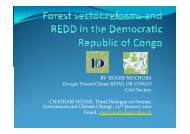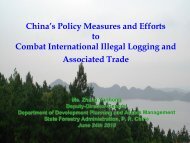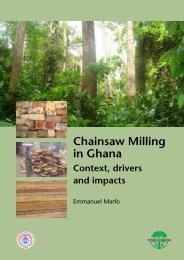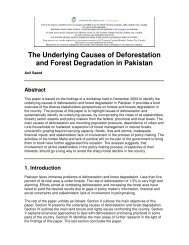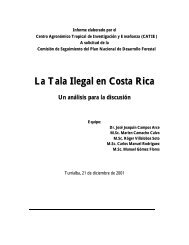download document - Rights and Resources Initiative
download document - Rights and Resources Initiative
download document - Rights and Resources Initiative
- No tags were found...
Create successful ePaper yourself
Turn your PDF publications into a flip-book with our unique Google optimized e-Paper software.
Historical <strong>and</strong> contemporary l<strong>and</strong> laws <strong>and</strong> their impact on indigenous peoples’ l<strong>and</strong> rights in Ug<strong>and</strong>a:The case of the BatwaThe Batwa have lost access to, <strong>and</strong> use of, their l<strong>and</strong> in various ways. The combination ofenvironment conservationists supported by donor agencies on the one h<strong>and</strong>, <strong>and</strong> the Ug<strong>and</strong>anGovernment on the other, have been at the forefront of evicting the Batwa from their l<strong>and</strong> in abid to establish national parks <strong>and</strong> forest reserves. 26 If the environmental campaign at firstappears defensible – it aims to prevent the complete destruction of forested areas, which nodoubt would have an adverse climatic effect, ultimately threatening lives – it nevertheless is awell-meaning ‘movement’ with grave shortcomings.In Ug<strong>and</strong>a, the conservation era began in the 1920s with the colonial protection of Bwindi,Mgahinga <strong>and</strong> Echuya forests. Bwindi was first gazetted as Kasatoro <strong>and</strong> Kayonza CrownForest Reserves in 1932 owing to its ecological <strong>and</strong> economic importance. 27 In 1942, the twoforest reserves were combined <strong>and</strong> gazetted as Impenetrable Central Crown Forest. In 1961,the Forest Reserve was additionally gazetted as a Gorilla Game Sanctuary. 28 The Batwa wereignored in the process of gazetting their forest areas. 29In the turbulent days of President Idi Amin’s rule (1971–79), little attention was paid to theforests. The governments of the day seem to have prioritised their grip on the mantle ofleadership over anything secondary, such as forest protection. This was a blessing for theBatwa; they continued to hunt <strong>and</strong> gather in the forest, which they still considered their own.There is evidence that widespread commercial hunting <strong>and</strong> timber extraction, <strong>and</strong> somemining, occurred. Most of those organising <strong>and</strong> carrying out these commercial activities werenot Batwa. 30In 1991, the conservation area was elevated to the status of a National Park by a resolution ofthe National Resistance Council passed on 13 August 1991, <strong>and</strong> became Bwindi ImpenetrableNational Park. 31 Prohibiting people from these forest areas put an end to the Batwa lifestyle offorest hunting <strong>and</strong> gathering. Financial compensation was given to only a few Batwahouseholds. The injustices in compensation have been <strong>document</strong>ed. Many Batwa worked <strong>and</strong>camped on others’ farms. They were classified as l<strong>and</strong>less squatters or workers <strong>and</strong> received norestitution, despite the forest being their ancestral territory. Instead their employers receivedcompensation for the huts that the Batwa had erected on their l<strong>and</strong>. 32 In Mgahinga, the processwas so intimidating that at least five Batwa households fled the region. Most of thecompensation went to farmers who had been destroying the forest since the 1930s. 33Amid all these injustices, World Bank funding was directed to the Mgahinga <strong>and</strong> BwindiImpenetrable Forest Conversation Trust, which was established in 1991 <strong>and</strong> became functionalin 1995. In order to establish the Trust, the World Bank required an assessment of the impact26 Ibid., p 14.27 Ug<strong>and</strong>a Wildlife Authority, Mgahinga Bwindi Conservation Area General Management Plan, 2000–2010,Kampala, (2000); see Tumushabe <strong>and</strong> Musiime (2006), p 3.28 General Notice N0. 584 (1961) as amended by Legal Notice N0. 53 (1962).29 Lewis (2000), p 20.30 Kingdom (1999), p 20.31 Statutory Instrument supplement N0. 3 (1992).32 Lewis (2000), p 20.33 Ibid.Nakayi 5January 2009




